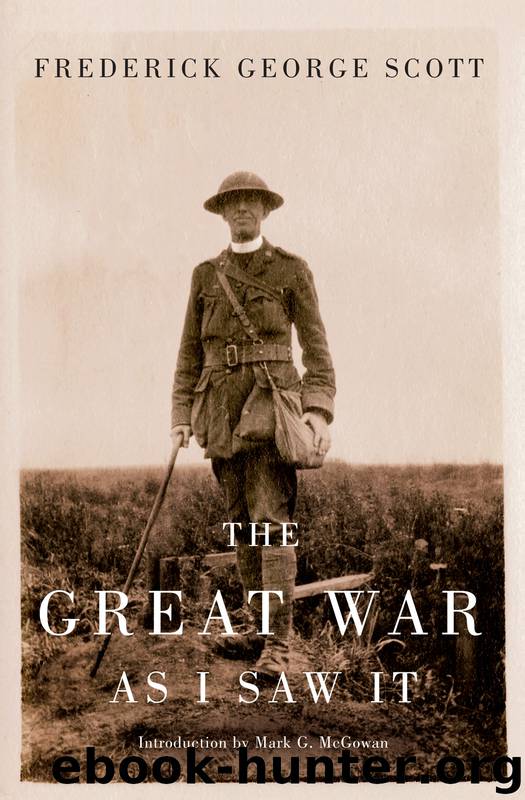The Great War as I Saw It - Scholar's Choice Edition by Frederick George Scott

Author:Frederick George Scott [Scott, Frederick George]
Language: eng
Format: epub
ISBN: 9781298056849
Google: HY9XrgEACAAJ
Publisher: Scholar's Choice
Published: 2015-02-16T20:53:13+00:00
XIII
Our Home at Camblain l’Abbé
November and December 1916
From Roellencourt we moved up to our new headquarters in the château at Camblain l’Abbé, which, after we left it in December, was long the home of the Canadian Corps. I had an Armstrong hut under the trees in the garden, and after it was lined with green canvas, and divided into two by green canvas curtains, it was quite artistic and very comfortable. Opposite the château we had a large French hut which was arranged as a cinema. The band of the 3rd Battalion was stationed in town and gave us a concert every evening, also playing at our services on Sundays. After the concert was over I used to announce a “rum issue” at half-past nine in the building. The men knew what it meant, and a good number would stay behind. Then I would give them a talk on temperance, astronomy, literature, or any subject about which I thought my audience knew less than I. We generally finished up by singing some well-known evening hymn. Very pleasant were the entertainments we had in that old cinema. One night, before a battalion was going up to the line, I proposed we should have a dance. The band furnished the music, and the men had one of the most enjoyable evenings they had ever had. Camblain l’Abbé was not a large place, so we were cramped for room, and a Nissen hut had to be built for “C” mess.
My little friend Philo had been stolen on our march, so his place was taken now by a brindle bull terrier which had been born in Albert. I called her “Alberta” and as time went on she became a well-known figure in the 1st Division. She often accompanied me on my walks to the trenches, and one day was out in no man’s land when a minenwerfer burst. Alberta did not wait for the bits to come down, but made one dive into the trench, to the amusement of the men, who said she knew the use of the trenches. She was my constant companion till her untimely end in 1918.
The country round about Camblain l’Abbé was very peaceful and pretty, and the road to the left from the château gave one a fine view of the towers of Mont St Eloi, which were not then damaged by shells. The two towers and the front wall of the old abbey were a striking object against the horizon, and could be seen for miles around. They made a beautiful picture in the distance when seen at sunset from the trenches beyond Arras. Those two towers must stand out in the foreground of all the memories which Canadians have of that region which was so long their war-home. As far as I could learn, Mont St Eloi had been the site of an old monastery which had been destroyed in the French Revolution, the towers and the walls of the church alone surviving. The farms of the monastery had passed to secular ownership, but were rich and well cultivated.
Download
This site does not store any files on its server. We only index and link to content provided by other sites. Please contact the content providers to delete copyright contents if any and email us, we'll remove relevant links or contents immediately.
The Vikings: Conquering England, France, and Ireland by Wernick Robert(79845)
Ali Pasha, Lion of Ioannina by Eugenia Russell & Eugenia Russell(40102)
The Conquerors (The Winning of America Series Book 3) by Eckert Allan W(36960)
The Vikings: Discoverers of a New World by Wernick Robert(36903)
Cecilia; Or, Memoirs of an Heiress — Volume 1 by Fanny Burney(32396)
Cecilia; Or, Memoirs of an Heiress — Volume 3 by Fanny Burney(31775)
Cecilia; Or, Memoirs of an Heiress — Volume 2 by Fanny Burney(31743)
Empire of the Sikhs by Patwant Singh(22922)
The Secret History by Donna Tartt(18787)
Hans Sturm: A Soldier's Odyssey on the Eastern Front by Gordon Williamson(18448)
Cat's cradle by Kurt Vonnegut(15126)
Pimp by Iceberg Slim(14252)
Sapiens: A Brief History of Humankind by Yuval Noah Harari(14183)
Talking to Strangers by Malcolm Gladwell(13156)
Norse Mythology by Gaiman Neil(13154)
Leonardo da Vinci by Walter Isaacson(13127)
4 3 2 1: A Novel by Paul Auster(12245)
Underground: A Human History of the Worlds Beneath Our Feet by Will Hunt(11992)
The Radium Girls by Kate Moore(11886)
